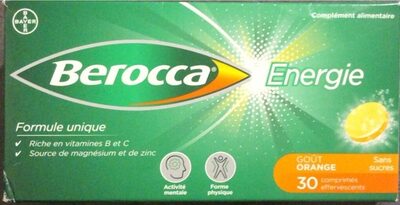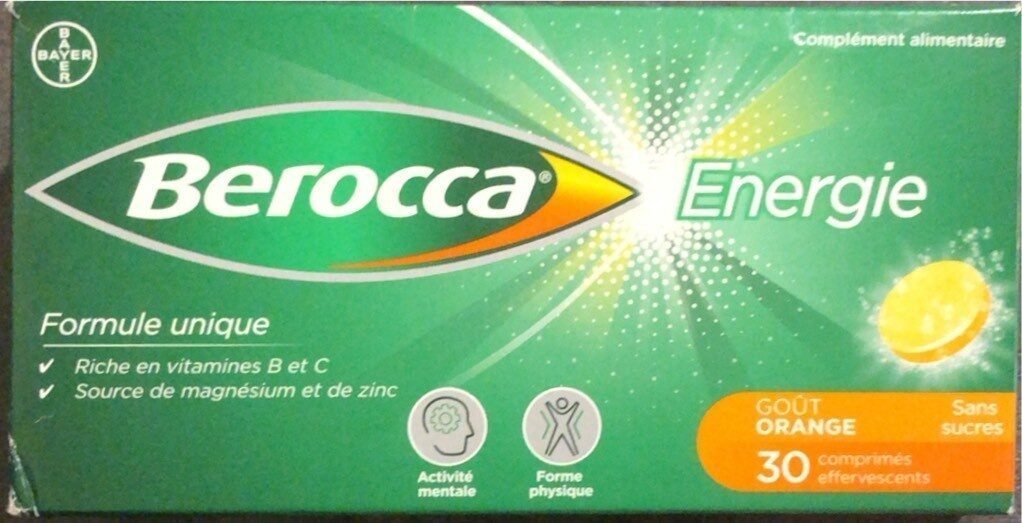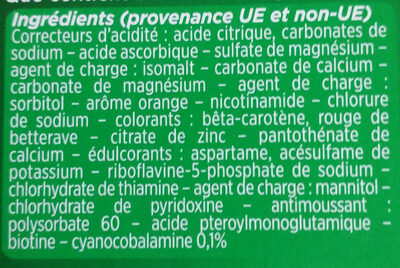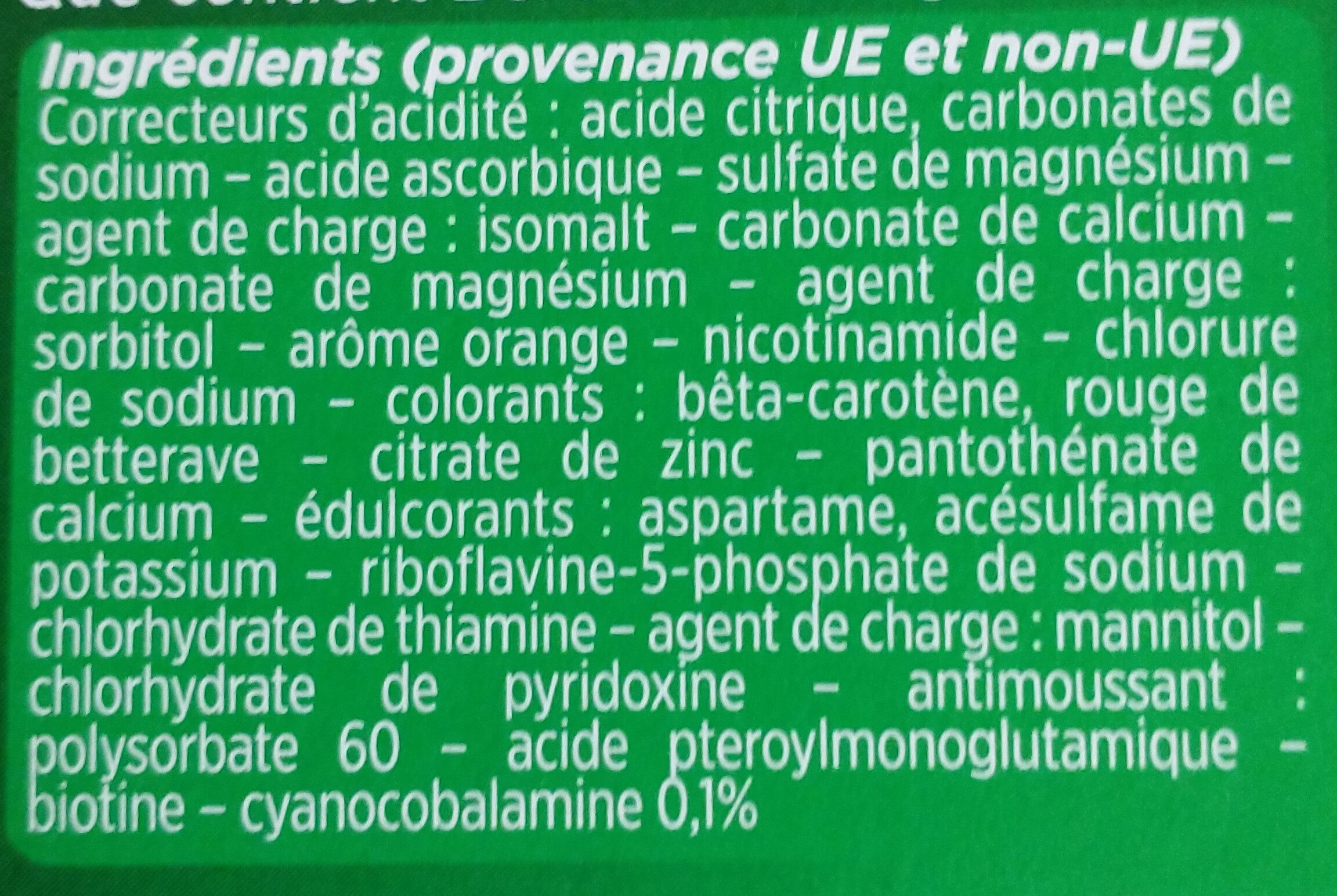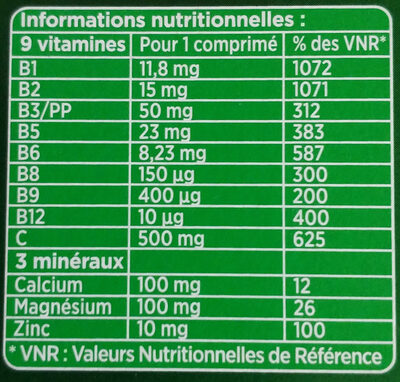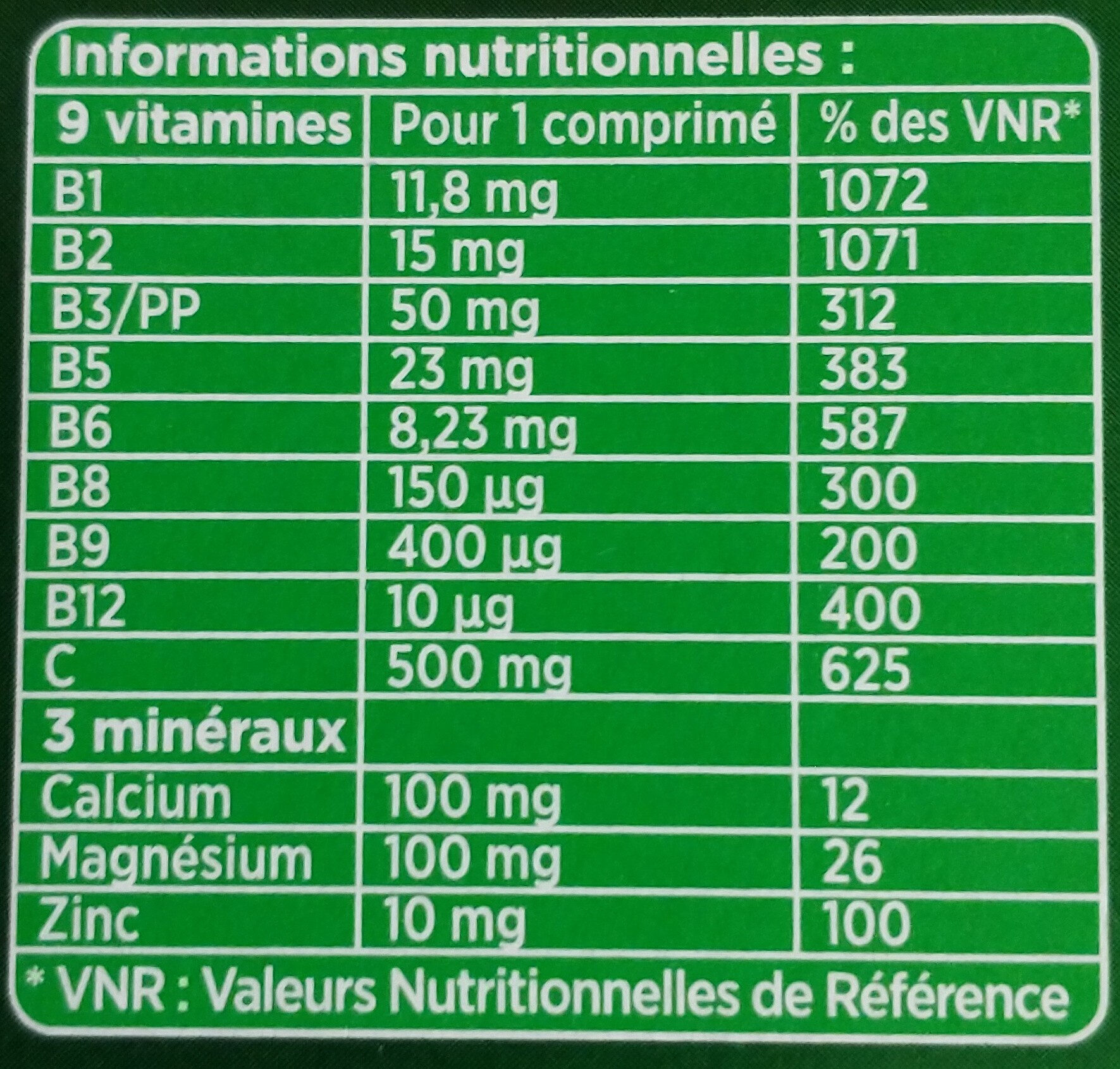Help us make food transparency the norm!
As a non-profit organization, we depend on your donations to continue informing consumers around the world about what they eat.
The food revolution starts with you!
Berocca Energie - Bayer - 30 comprimés
Berocca Energie - Bayer - 30 comprimés
This product page is not complete. You can help to complete it by editing it and adding more data from the photos we have, or by taking more photos using the app for Android or iPhone/iPad. Thank you!
×
Barcode: 3534510000672 (EAN / EAN-13)
Quantity: 30 comprimés
Packaging: fr:Carton plastique
Brands: Bayer
Categories: Dietary supplements
Labels, certifications, awards: Made in France
Countries where sold: France
Matching with your preferences
Health
Ingredients
-
28 ingredients
French: Ingrédients (provenance UE et non-UE) Correcteurs d'ačidité : acide citrique, carbonates de sodium - acide ascorbique - sulfate de magnésium agent de charge : isomalt - carbonate de calcium carbonate de magnésium - agent de charge: sorbitol - arôme orange - nicotínamide - chlorure de sodium - colorants : bêta-carotène, rouge de betterave calcium - édulcorants : aspartame, acésulfame de potassium - riboflavine-5-phosphate de sodium · chlorhydrate de thiamine - agent de charge : mannitol - chlorhydrate de pyridoxine polysorbate 60 - acide pteroylmonoglutamique biotine - cyanocobalamine 0,1% - citrate de zinc pantothénate de antimoussant
Food processing
-
Ultra processed foods
Elements that indicate the product is in the 4 - Ultra processed food and drink products group:
- Additive: E101 - Riboflavin
- Additive: E160a - Carotene
- Additive: E162 - Beetroot red
- Additive: E420 - Sorbitol
- Additive: E421 - Mannitol
- Additive: E950 - Acesulfame k
- Additive: E951 - Aspartame
- Additive: E953 - Isomalt
- Ingredient: Bulking agent
- Ingredient: Colour
- Ingredient: Flavouring
- Ingredient: Sweetener
Food products are classified into 4 groups according to their degree of processing:
- Unprocessed or minimally processed foods
- Processed culinary ingredients
- Processed foods
- Ultra processed foods
The determination of the group is based on the category of the product and on the ingredients it contains.
Additives
-
E101 - Riboflavin
Riboflavin: Riboflavin, also known as vitamin B2, is a vitamin found in food and used as a dietary supplement. Food sources include eggs, green vegetables, milk and other dairy product, meat, mushrooms, and almonds. Some countries require its addition to grains. As a supplement it is used to prevent and treat riboflavin deficiency and prevent migraines. It may be given by mouth or injection.It is nearly always well tolerated. Normal doses are safe during pregnancy. Riboflavin is in the vitamin B group. It is required by the body for cellular respiration.Riboflavin was discovered in 1920, isolated in 1933, and first made in 1935. It is on the World Health Organization's List of Essential Medicines, the most effective and safe medicines needed in a health system. Riboflavin is available as a generic medication and over the counter. In the United States a month of supplements costs less than 25 USD.Source: Wikipedia
-
E101i - Riboflavin
Riboflavin: Riboflavin, also known as vitamin B2, is a vitamin found in food and used as a dietary supplement. Food sources include eggs, green vegetables, milk and other dairy product, meat, mushrooms, and almonds. Some countries require its addition to grains. As a supplement it is used to prevent and treat riboflavin deficiency and prevent migraines. It may be given by mouth or injection.It is nearly always well tolerated. Normal doses are safe during pregnancy. Riboflavin is in the vitamin B group. It is required by the body for cellular respiration.Riboflavin was discovered in 1920, isolated in 1933, and first made in 1935. It is on the World Health Organization's List of Essential Medicines, the most effective and safe medicines needed in a health system. Riboflavin is available as a generic medication and over the counter. In the United States a month of supplements costs less than 25 USD.Source: Wikipedia
-
E160a - Carotene
Carotene: The term carotene -also carotin, from the Latin carota, "carrot"- is used for many related unsaturated hydrocarbon substances having the formula C40Hx, which are synthesized by plants but in general cannot be made by animals -with the exception of some aphids and spider mites which acquired the synthesizing genes from fungi-. Carotenes are photosynthetic pigments important for photosynthesis. Carotenes contain no oxygen atoms. They absorb ultraviolet, violet, and blue light and scatter orange or red light, and -in low concentrations- yellow light. Carotenes are responsible for the orange colour of the carrot, for which this class of chemicals is named, and for the colours of many other fruits, vegetables and fungi -for example, sweet potatoes, chanterelle and orange cantaloupe melon-. Carotenes are also responsible for the orange -but not all of the yellow- colours in dry foliage. They also -in lower concentrations- impart the yellow coloration to milk-fat and butter. Omnivorous animal species which are relatively poor converters of coloured dietary carotenoids to colourless retinoids have yellowed-coloured body fat, as a result of the carotenoid retention from the vegetable portion of their diet. The typical yellow-coloured fat of humans and chickens is a result of fat storage of carotenes from their diets. Carotenes contribute to photosynthesis by transmitting the light energy they absorb to chlorophyll. They also protect plant tissues by helping to absorb the energy from singlet oxygen, an excited form of the oxygen molecule O2 which is formed during photosynthesis. β-Carotene is composed of two retinyl groups, and is broken down in the mucosa of the human small intestine by β-carotene 15‚15'-monooxygenase to retinal, a form of vitamin A. β-Carotene can be stored in the liver and body fat and converted to retinal as needed, thus making it a form of vitamin A for humans and some other mammals. The carotenes α-carotene and γ-carotene, due to their single retinyl group -β-ionone ring-, also have some vitamin A activity -though less than β-carotene-, as does the xanthophyll carotenoid β-cryptoxanthin. All other carotenoids, including lycopene, have no beta-ring and thus no vitamin A activity -although they may have antioxidant activity and thus biological activity in other ways-. Animal species differ greatly in their ability to convert retinyl -beta-ionone- containing carotenoids to retinals. Carnivores in general are poor converters of dietary ionone-containing carotenoids. Pure carnivores such as ferrets lack β-carotene 15‚15'-monooxygenase and cannot convert any carotenoids to retinals at all -resulting in carotenes not being a form of vitamin A for this species-; while cats can convert a trace of β-carotene to retinol, although the amount is totally insufficient for meeting their daily retinol needs.Source: Wikipedia
-
E160ai - Beta-carotene
Beta-Carotene: β-Carotene is an organic, strongly colored red-orange pigment abundant in plants and fruits. It is a member of the carotenes, which are terpenoids -isoprenoids-, synthesized biochemically from eight isoprene units and thus having 40 carbons. Among the carotenes, β-carotene is distinguished by having beta-rings at both ends of the molecule. β-Carotene is biosynthesized from geranylgeranyl pyrophosphate.β-Carotene is the most common form of carotene in plants. When used as a food coloring, it has the E number E160a. The structure was deduced by Karrer et al. in 1930. In nature, β-carotene is a precursor -inactive form- to vitamin A via the action of beta-carotene 15‚15'-monooxygenase.Isolation of β-carotene from fruits abundant in carotenoids is commonly done using column chromatography. It can also be extracted from the beta-carotene rich algae, Dunaliella salina. The separation of β-carotene from the mixture of other carotenoids is based on the polarity of a compound. β-Carotene is a non-polar compound, so it is separated with a non-polar solvent such as hexane. Being highly conjugated, it is deeply colored, and as a hydrocarbon lacking functional groups, it is very lipophilic.Source: Wikipedia
-
E162 - Beetroot red
Betanin: Betanin, or Beetroot Red, is a red glycosidic food dye obtained from beets; its aglycone, obtained by hydrolyzing away the glucose molecule, is betanidin. As a food additive, its E number is E162. The color of betanin depends on pH; between four and five it is bright bluish-red, becoming blue-violet as the pH increases. Once the pH reaches alkaline levels betanin degrades by hydrolysis, resulting in a yellow-brown color. Betanin is a betalain pigment, together with isobetanin, probetanin, and neobetanin. Other pigments contained in beet are indicaxanthin and vulgaxanthins.Source: Wikipedia
-
E330 - Citric acid
Citric acid is a natural organic acid found in citrus fruits such as lemons, oranges, and limes.
It is widely used in the food industry as a flavor enhancer, acidulant, and preservative due to its tart and refreshing taste.
Citric acid is safe for consumption when used in moderation and is considered a generally recognized as safe (GRAS) food additive by regulatory agencies worldwide.
-
E420 - Sorbitol
Sorbitol: Sorbitol --, less commonly known as glucitol --, is a sugar alcohol with a sweet taste which the human body metabolizes slowly. It can be obtained by reduction of glucose, which changes the aldehyde group to a hydroxyl group. Most sorbitol is made from corn syrup, but it is also found in nature, for example in apples, pears, peaches, and prunes. It is converted to fructose by sorbitol-6-phosphate 2-dehydrogenase. Sorbitol is an isomer of mannitol, another sugar alcohol; the two differ only in the orientation of the hydroxyl group on carbon 2. While similar, the two sugar alcohols have very different sources in nature, melting points, and uses.Source: Wikipedia
-
E421 - Mannitol
Mannitol: Mannitol is a type of sugar alcohol which is also used as a medication. As a sugar, it is often used as a sweetener in diabetic food, as it is poorly absorbed from the intestines. As a medication, it is used to decrease pressure in the eyes, as in glaucoma, and to lower increased intracranial pressure. Medically, it is given by injection. Effects typically begin within 15 minutes and last up to 8 hours.Common side effects from medical use include electrolyte problems and dehydration. Other serious side effects may include worsening heart failure and kidney problems. It is unclear if use is safe in pregnancy. Mannitol is in the osmotic diuretic family of medications and works by pulling fluid from the brain and eyes.The discovery of mannitol is attributed to Joseph Louis Proust in 1806. It is on the World Health Organization's List of Essential Medicines, the most effective and safe medicines needed in a health system. The wholesale cost in the developing world is about US$1.12 to 5.80 a dose. In the United States, a course of treatment costs $25 to 50. It was originally made from the flowering ash and called manna due to its supposed resemblance to the Biblical food. Mannitol is on the World Anti-Doping Agency's banned drug list due to concerns that it may mask other drugs.Source: Wikipedia
-
E950 - Acesulfame k
Acesulfame potassium: Acesulfame potassium - AY-see-SUL-faym-, also known as acesulfame K -K is the symbol for potassium- or Ace K, is a calorie-free sugar substitute -artificial sweetener- often marketed under the trade names Sunett and Sweet One. In the European Union, it is known under the E number -additive code- E950. It was discovered accidentally in 1967 by German chemist Karl Clauss at Hoechst AG -now Nutrinova-. In chemical structure, acesulfame potassium is the potassium salt of 6-methyl-1‚2,3-oxathiazine-4-3H--one 2‚2-dioxide. It is a white crystalline powder with molecular formula C4H4KNO4S and a molecular weight of 201.24 g/mol.Source: Wikipedia
-
E951 - Aspartame
Aspartame: Aspartame -APM- is an artificial non-saccharide sweetener used as a sugar substitute in some foods and beverages. In the European Union, it is codified as E951. Aspartame is a methyl ester of the aspartic acid/phenylalanine dipeptide. A panel of experts set up by the European Food Safety Authority concluded in 2013 that aspartame is safe for human consumption at current levels of exposure. As of 2018, evidence does not support a long-term benefit for weight loss or in diabetes. Because its breakdown products include phenylalanine, people with the genetic condition phenylketonuria -PKU- must be aware of this as an additional source.It was first sold under the brand name NutraSweet. It was first made in 1965, and the patent expired in 1992. It was initially approved for use in food products by the U.S. Food and Drug Administration -FDA- in 1981. The safety of aspartame has been the subject of several political and medical controversies, United States congressional hearings, and Internet hoaxes.Source: Wikipedia
-
E953 - Isomalt
Isomalt: Isomalt is a sugar substitute, a type of sugar alcohol used primarily for its sugar-like physical properties. It has little to no impact on blood sugar levels, and does not stimulate the release of insulin. It also does not promote tooth decay, i.e. is tooth-friendly. Its energy value is 2 kcal/g, half that of sugars. However, like most sugar alcohols, it carries a risk of gastric distress, including flatulence and diarrhea, when consumed in large quantities -above about 20-30 g per day-. Isomalt may prove upsetting to the intestinal tract because it is incompletely absorbed in the small intestine, and when polyols pass into the large intestine, they can cause osmotically induced diarrhea and stimulate the gut flora, causing flatulence. As with other dietary fibers, regular consumption of isomalt can lead to desensitisation, decreasing the risk of intestinal upset. Isomalt can be blended with high-intensity sweeteners such as sucralose, giving a mixture that has the same sweetness as sugar. Isomalt is an equimolar mixture of two mutually diastereomeric disaccharides, each composed of two sugars: glucose and mannitol -α-D-glucopyranosido-1‚6-mannitol- and also glucose and sorbitol -α-D-glucopyranosido-1‚6-sorbitol-. Complete hydrolysis of isomalt yields glucose -50%-, sorbitol -25%-, and mannitol -25%-. It is an odorless, white, crystalline substance containing about 5% water of crystallisation. Isomalt has a minimal cooling effect -positive heat of solution-, lower than many other sugar alcohols, in particular, xylitol and erythritol. Isomalt is manufactured in a two-stage process in which sucrose is first transformed into isomaltulose, a reducing disaccharide -6-O-α-D-glucopyranosido-D-fructose-. The isomaltulose is then hydrogenated, using a Raney nickel catalyst. The final product — isomalt — is an equimolar composition of 6-O-α-D-glucopyranosido-D-sorbitol -1‚6-GPS- and 1-O-α-D-glucopyranosido-D-mannitol-dihydrate -1‚1-GPM-dihydrate-. Isomalt has been approved for use in the United States since 1990. It is also permitted for use in Australia, New Zealand, Canada, Mexico, Iran, the European Union, and other countries. Isomalt is widely used for the production of sugar-free candy, especially hard-boiled candy, because it resists crystallisation much better than the standard combinations of sucrose and corn syrup. It is used in sugar sculpture for the same reason.Source: Wikipedia
Ingredients analysis
-
May contain palm oil
Ingredients that may contain palm oil: E160ai
-
Vegan status unknown
Unrecognized ingredients: fr:ingredients, fr:provenance-ue-et-non-ue, fr:correcteurs-d-ačidite, fr:sulfate-de-magnesium-agent-de-charge, fr:carbonate-de-calcium-carbonate-de-magnesium, Sodium chloride, fr:rouge-de-betterave-calcium, fr:riboflavine-5-phosphate-de-sodium, Thiamin hydrochloride, fr:chlorhydrate-de-pyridoxine-polysorbate-60, fr:acide-pteroylmonoglutamique-biotine, Cyanocobalamin, fr:citrate-de-zinc-pantothenate-de-antimoussantSome ingredients could not be recognized.
We need your help!
You can help us recognize more ingredients and better analyze the list of ingredients for this product and others:
- Edit this product page to correct spelling mistakes in the ingredients list, and/or to remove ingredients in other languages and sentences that are not related to the ingredients.
- Add new entries, synonyms or translations to our multilingual lists of ingredients, ingredient processing methods, and labels.
If you would like to help, join the #ingredients channel on our Slack discussion space and/or learn about ingredients analysis on our wiki. Thank you!
-
Vegetarian status unknown
Unrecognized ingredients: fr:ingredients, fr:provenance-ue-et-non-ue, fr:correcteurs-d-ačidite, fr:sulfate-de-magnesium-agent-de-charge, fr:carbonate-de-calcium-carbonate-de-magnesium, Sodium chloride, fr:rouge-de-betterave-calcium, fr:riboflavine-5-phosphate-de-sodium, Thiamin hydrochloride, fr:chlorhydrate-de-pyridoxine-polysorbate-60, fr:acide-pteroylmonoglutamique-biotine, Cyanocobalamin, fr:citrate-de-zinc-pantothenate-de-antimoussantSome ingredients could not be recognized.
We need your help!
You can help us recognize more ingredients and better analyze the list of ingredients for this product and others:
- Edit this product page to correct spelling mistakes in the ingredients list, and/or to remove ingredients in other languages and sentences that are not related to the ingredients.
- Add new entries, synonyms or translations to our multilingual lists of ingredients, ingredient processing methods, and labels.
If you would like to help, join the #ingredients channel on our Slack discussion space and/or learn about ingredients analysis on our wiki. Thank you!
-
Details of the analysis of the ingredients
We need your help!
Some ingredients could not be recognized.
We need your help!
You can help us recognize more ingredients and better analyze the list of ingredients for this product and others:
- Edit this product page to correct spelling mistakes in the ingredients list, and/or to remove ingredients in other languages and sentences that are not related to the ingredients.
- Add new entries, synonyms or translations to our multilingual lists of ingredients, ingredient processing methods, and labels.
If you would like to help, join the #ingredients channel on our Slack discussion space and/or learn about ingredients analysis on our wiki. Thank you!
fr: Ingrédients (provenance UE et non-UE), Correcteurs d'ačidité (acide citrique), carbonates de sodium, acide ascorbique, sulfate de magnésium agent de charge (isomalt), carbonate de calcium carbonate de magnésium, agent de charge (sorbitol), arôme orange, nicotínamide, chlorure de sodium, colorants (bêta-carotène), rouge de betterave calcium, édulcorants (aspartame), acésulfame de potassium, riboflavine-5-phosphate de sodium, chlorhydrate de thiamine, agent de charge (mannitol), chlorhydrate de pyridoxine polysorbate 60, acide pteroylmonoglutamique biotine, cyanocobalamine 0.1%, citrate de zinc pantothénate de antimoussant- Ingrédients -> fr:ingredients - percent_min: 4.76190476190476 - percent_max: 98.1
- provenance UE et non-UE -> fr:provenance-ue-et-non-ue - percent_min: 4.76190476190476 - percent_max: 98.1
- Correcteurs d'ačidité -> fr:correcteurs-d-ačidite - percent_min: 0.1 - percent_max: 49.1
- acide citrique -> en:e330 - vegan: yes - vegetarian: yes - percent_min: 0 - percent_max: 49.1
- carbonates de sodium -> en:e500 - vegan: yes - vegetarian: yes - percent_min: 0.1 - percent_max: 32.7666666666667
- acide ascorbique -> en:e300 - vegan: yes - vegetarian: yes - percent_min: 0.1 - percent_max: 24.6
- sulfate de magnésium agent de charge -> fr:sulfate-de-magnesium-agent-de-charge - percent_min: 0.1 - percent_max: 19.7
- isomalt -> en:e953 - vegan: yes - vegetarian: yes - percent_min: 0 - percent_max: 19.7
- carbonate de calcium carbonate de magnésium -> fr:carbonate-de-calcium-carbonate-de-magnesium - percent_min: 0.1 - percent_max: 16.4333333333333
- agent de charge -> en:bulking-agent - percent_min: 0.1 - percent_max: 14.1
- sorbitol -> en:e420 - vegan: yes - vegetarian: yes - percent_min: 0 - percent_max: 14.1
- arôme orange -> en:orange-flavouring - vegan: maybe - vegetarian: maybe - percent_min: 0.1 - percent_max: 5
- nicotínamide -> en:e375 - vegan: maybe - vegetarian: maybe - percent_min: 0.1 - percent_max: 5
- chlorure de sodium -> en:sodium-chloride - percent_min: 0.1 - percent_max: 5
- colorants -> en:colour - percent_min: 0.1 - percent_max: 5
- bêta-carotène -> en:e160ai - vegan: maybe - vegetarian: maybe - from_palm_oil: maybe - percent_min: 0 - percent_max: 5
- rouge de betterave calcium -> fr:rouge-de-betterave-calcium - percent_min: 0.1 - percent_max: 5
- édulcorants -> en:sweetener - percent_min: 0.1 - percent_max: 5
- aspartame -> en:e951 - vegan: yes - vegetarian: yes - percent_min: 0 - percent_max: 5
- acésulfame de potassium -> en:e950 - vegan: yes - vegetarian: yes - percent_min: 0.1 - percent_max: 5
- riboflavine-5-phosphate de sodium -> fr:riboflavine-5-phosphate-de-sodium - percent_min: 0.1 - percent_max: 5
- chlorhydrate de thiamine -> en:thiamin-hydrochloride - percent_min: 0.1 - percent_max: 5
- agent de charge -> en:bulking-agent - percent_min: 0.1 - percent_max: 5
- mannitol -> en:e421 - vegan: yes - vegetarian: yes - percent_min: 0 - percent_max: 5
- chlorhydrate de pyridoxine polysorbate 60 -> fr:chlorhydrate-de-pyridoxine-polysorbate-60 - percent_min: 0.1 - percent_max: 5
- acide pteroylmonoglutamique biotine -> fr:acide-pteroylmonoglutamique-biotine - percent_min: 0.1 - percent_max: 5
- cyanocobalamine -> en:cyanocobalamin - percent_min: 0.1 - percent: 0.1 - percent_max: 0.1
- citrate de zinc pantothénate de antimoussant -> fr:citrate-de-zinc-pantothenate-de-antimoussant - percent_min: 0 - percent_max: 0.1
Nutrition
-
Missing data to compute the Nutri-Score
Missing nutrition facts
⚠ ️The nutrition facts of the product must be specified in order to compute the Nutri-Score.Could you add the information needed to compute the Nutri-Score? Add nutrition facts
-
Nutrition facts
Nutrition facts As sold
for 100 g / 100 mlCompared to: Dietary supplements Fat ? Saturated fat ? Carbohydrates ? Sugars ? Maltodextrins 0.1 g Fiber ? Proteins ? Salt ? Vitamin B1 (Thiamin) 11.8 mg +190% Vitamin B2 (Riboflavin) 15 mg +389% Vitamin B3/PP (Niacin) 50 mg +131% Vitamin B6 (Pyridoxin) 8.23 mg -17% Vitamin B12 (cobalamin) 400,000 µg +1,587,202% Vitamin B5 (Pantothenic acid) 100 mg +952% Fruits‚ vegetables‚ nuts and rapeseed‚ walnut and olive oils (estimate from ingredients list analysis) 0 %
Environment
-
Eco-Score not computed - Unknown environmental impact
We could not compute the Eco-Score of this product as it is missing some data, could you help complete it?Could you add a precise product category so that we can compute the Eco-Score? Add a category
Packaging
-
Packaging with a medium impact
-
Packaging parts
(Plastic)
-
Packaging materials
Material % Packaging weight Plastic
-
Transportation
-
Origins of ingredients
Missing origins of ingredients information
⚠ ️ The origins of the ingredients of this product are not indicated.
If they are indicated on the packaging, you can modify the product sheet and add them.
If you are the manufacturer of this product, you can send us the information with our free platform for producers.Add the origins of ingredients for this product Add the origins of ingredients for this product
Report a problem
-
Incomplete or incorrect information?
Category, labels, ingredients, allergens, nutritional information, photos etc.
If the information does not match the information on the packaging, please complete or correct it. Open Food Facts is a collaborative database, and every contribution is useful for all.
Data sources
Product added on by kiliweb
Last edit of product page on by fix-serving-size-bot.
Product page also edited by ecoscore-impact-estimator, nico01, openfoodfacts-contributors, packbot, yuka.sY2b0xO6T85zoF3NwEKvlkZDCt3ygiiUbzXVi3SO1_aHP7zTYNp7-ZXLKas, yuka.sY2b0xO6T85zoF3NwEKvllZIbtWPvm2ZDkX4g0a5no--E5f0f4lO86L5LKs.
